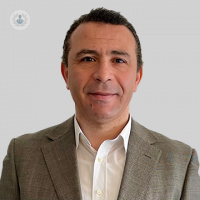Thoracic outlet syndrome (TOS): what are the treatment options?
Escrito por:Thoracic outlet syndrome (TOS) can lead to symptoms that include pain and tingling or weakness in your shoulder and arm. There are three types of the condition and each requires different treatment, which could involve physiotherapy, medications or even surgery in some cases. Here, one of our leading consultant vascular surgeons Mr Mohamed Abdelhamid describes the possible treatment options for each type of TOS.
What are my treatment options for TOS?
The types of TOS include neurogenic TOS, venous TOS and arterial TOS. Let’s look at the treatment options for the three sub-types:
Neurogenic TOS
If you are at risk of developing TOS (because of the nature of your job or from sport), avoid repeated movements and lifting heavy weights. Losing weight is important to prevent or relieve symptoms of TOS. Avoiding lifting heavy bags over the shoulder, stretching and daily exercises to strengthen the shoulder muscles can all help to relieve or avoid symptoms.
Physiotherapy can cause relief of muscle spasm, improve postural imbalance, improve arm mobility and reduce the strain exposure. This should be carried out by experienced and specialised physiotherapist who is familiar with these cases.
Medications, such as pain killers and muscle relaxants should be prescribed by your doctor.
Surgery is indicated when conservative measures have failed in improving the symptoms after several months and in the presence of persistent disabling symptoms that interfere with daily activities. The aim of surgery is to relieve the pressure of the brachial plexus. This is achieved by removing the compressing agent e.g. scalene muscles, part of the first rib, any fibrous band or extra rib (cervical rib).
Venous TOS
Any young and middle-aged patient with upper limb deep vein thrombosis (DVT) should be investigated for the possibility of venous TOS until proven otherwise. Patient with upper limb DVT should be considered for thrombolysis (clot-busting) as long there are not contra-indicated. Once the clot is dissolved, the patient should receive anticoagulation (blood thinning medication) to prevent recurrence of a blood clot.
If venous TOS was found to be the cause of the arm DVT and the clot has dissolved, surgical treatment should be considered as it provides the definitive management for venous TOS.
This is the same as in neurogenic TOS with the goal of decompressing the subclavian vein and collateral venous blood flow in addition to the restoration of normal blood flow through the subclavian vein.
Arterial TOS
If arterial TOS is diagnosed before any complication e.g. blood clot blocking the blood flow, the patient should start on oral anticoagulation (blood thinners tablets) to prevent any blood clot.
This should be followed by considering surgical decompression of the subclavian artery by removing the compressing factor. If the subclavian artery has developed small swelling (aneurysm), the subclavian artery should be repaired by bypass operation. The decompression and bypass will be carried out in the same setting.
If the patient had a blood clot blocking the blood flow to the hand, the patient should be hospitalised to start blood thinners by injection (heparin) and the patient will require thrombolysis (clot-busting) or surgical removal of the blood clot (embolectomy). After this, decompression surgery and repair of the subclavian artery should be considered.
Read more on the symptoms of TOS
If you would like to see Mr Abdelhamid, you can book an appointment with him via his Top Doctor’s profile here. Can’t visit in person? He is also available for a video call using our e-Consultation tool, which can also be found on his profile.



